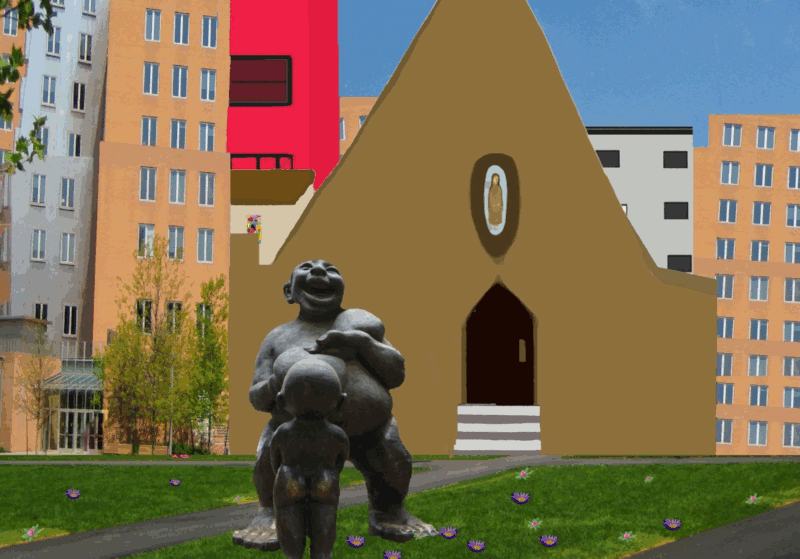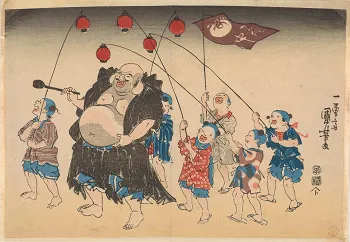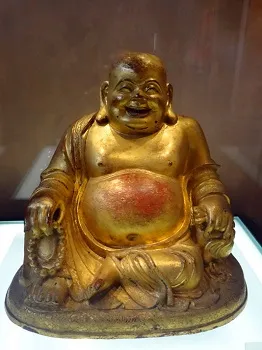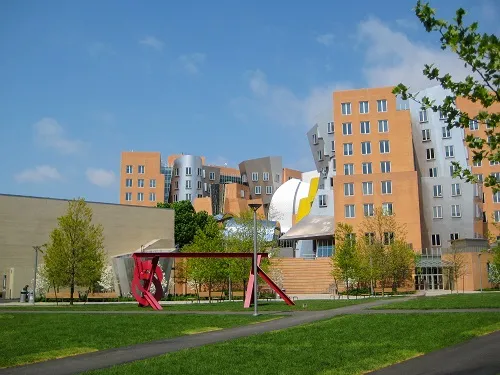
It is recorded in Chinese history that a monk lived in the tenth century who came to be known as Budai. He also came to be known as the Laughing Buddha. Budai is much revered in several Asian cultures.
Tradition suggests that Budai carried all his possessions in a sack (Budai means "cloth Sack"). According to legend, children would follow the monk as he walked about. Today his figure represents love, peace and contentment.

Seventeenth Century Japanese Painting of Budai (Also Known as Hotei)

Image credited to Kano Koi, a painter. Public domain.

Almost all representations of Budai show him smiling or laughing. And almost always he is carrying a sack, as he is in the sculpture shown in my collage. (Note there is a child with him in the picture.)
Budai is represented as a very fat monk. Hence, the name Fat Buddha is also sometimes used in referring to him. It is believed by some that rubbing the belly of a Fat Budai statue brings good fortune.

Budai (Hotei) and Children Carrying Lanterns

Image Credit: Freer/Sackler Gallery. Used under a CC 4.0 license. Picture was painted by Utagawa Kuniyoshi in the early to mid 19th century.

There are some who consider Budai to be a manifestation of Maitreya Buddha, Future Buddha. According to the Encyclopedia Britannica, Maitreya Buddha will "descend to earth to preach anew the dharma (“law”) when the teachings of Gautama Buddha have completely decayed".

Budai as Maitreya Buddha, at Luoyang Museum, China

Image credits: Baomi. Used under CC 4.0 license.The age of this statue is not given, but according to one travel site, the tripgoeson, "The Luoyang Museum of Ancient Art is a collection of...some of China’s most notable emperors from the Wei Dynasty to the Sui and Tang Dynasties".

My Collage
When I first saw @shaka's photo, I appreciated the artistic merit of the design but did not respond to the picture emotionally.
@shaka's Photo


I think I'm hardwired to respond to nature, because of an early childhood spent in a rural setting. So, in my collage, I separate the sterility of the buildings and the ground sculpture, from the green area in the foreground. A church represents the division between the sterile and the vibrant/emotional.
Materials
Elements from two pictures I had drawn some years ago (for a possible memoir) were combined with elements from @shaka's photo.




The statue of Budai came from Pixaby, and is credited to hyeonjukim.

Some of the flowers (derived from a single flower,) also came from Pixabay, and are credited to luckyhand2010.


Most of the flowers, however, came from Paint 3D.
Why so many flowers? Because, besides the fact that they suggest life and joy...it has been said that when Buddha was a baby and began to walk, at "each step a lotus flower appeared on the ground".

The current round of #LMAC, with rules and conditions, may be found at @shaka's blog. Many beautiful collages are already featured there. Take a look!
Thank you @shaka, for offering the community another opportunity to express our creativity.

